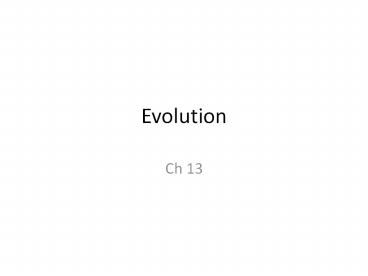Evolution - PowerPoint PPT Presentation
1 / 32
Title: Evolution
1
Evolution
- Ch 13
2
Historical Theories
- Anaximander (2500 yrs ago)
- Aristotle
- Georges Buffon (1700s)
- Jean Baptist Lemark (late 1700s - early1800s)
- Erasmus Darwin
3
Charles Darwin
1859
1874
4
Voyage of the HMS Beagle
5
On the Origin of Species
- Descent With Modification
- By means of Natural Selection
6
How Did Darwin Come Up With His Ideas?
- Scientific Method
- Key observations
- Traits vary in a population
- Most traits are inherited from parent to
offspring - More offspring are produced than the environment
can support (Thomas Malthus)
7
Trait Variation
8
Recap
- Limited resources
- Overproduction of offspring
- Heritable individual variation
- Therefore, survival depends partly on inherited
features
9
Darwins Theory of Evolution
- In a varied population, individuals whose
inherited characters best adapt them to the
environment are more likely to survive and
reproduce. - Therefore, more fit individuals tend to leave
more offspring than less fit individuals. - Natural Selection is the mechanism
- Reproduction (differential) is Key
10
Natural Selection
11
Artificial Selection
12
Observing natural selection
0
- Camouflage adaptations that evolved in different
environments
13
Pestacide Resistance
0
14
Antibiotic resistance
0
- The excessive use of antibiotics is leading to
the evolution of antibiotic-resistant bacteria
Colorized SEM 5,600?
Figure 13.13
15
Natural Selection Experiment
- Darwin Finches (Galapagos Finches)
- Similar EXCEPT for beaks
- Beaks specialization
16
Support for Descent with Modification
- Biogeography
- Fossil Record
- Molecular Biology, Biochemistry, Cell Biology
- Comparative Anatomy
17
Biogeography
0
- Geographic distribution of species
- Galápagos animals resembled species of the South
American mainland more than animals on similar
but distant islands - Organisms may have common ancestor
18
Fossil Evidence
0
- Organisms evolved in a historical sequence
A Skull of Homoerectus
D Dinosaur tracks
B Petrified tree
C Ammonite casts
E Fossilized organicmatter of a leaf
G Ice Man
F Insect in amber
Figure 13.3AG
19
Fossil Evidence
0
- Many fossils link early extinct species with
species living today
20
Comparative Anatomy
0
- Comparison of body structures in different
species - Homology- similar characteristics resulting from
common ancestry - Homologous structures- features with different
functions but structurally similar due to common
ancestry
21
Comparative Embryology
0
- Comparison of early stages of development among
different organisms
22
Molecular Biology
0
- Comparisons of DNA and amino acid sequences
between different organisms to reveal
evolutionary relationships
23
Unit of Evolution
0
- Evolution acts on individuals, affects whole
populations - Populations are the unit of evolution
- Group of individuals of the same species living
in the same place at the same time
24
Unit of Evolution
- Evolution is change in prevalence of heritable
traits in population through time - A gene pool
- Is the total collection of genes in a population
at any one time - Microevolution
- Is a change in the relative frequencies of
alleles in a gene pool
25
Hardy-Weinberg Equilibrium
- Frequency of alleles in a stable population will
not change over time - Very large population
- Population is isolated
- Mutations dont alter gene pool
- Random mating
- All individuals are equal in reproductive success
- In reality, this never happens
26
Agents of Change
- Genetic Drift
- Bottle neck affect
- Founder affect
- Gene Flow
- Mutation
- Non Random Mating
- Natural Selection
27
Variation
0
- Extensive in most populations
- Mutation and sexual recombination generate
variation and can create new alleles.
28
Endangered species often have reduced variation
0
- Low genetic variability
- May reduce the capacity of endangered species to
survive as humans continue to alter the
environment
Figure 13.10
29
Types of Selection
30
Sexual Selection
- Sexual Dimorphism
- Sexual Selection- where individuals with certain
characteristics are more likely to obtain mates
than others. - Intrasexual selection
- Intersexual selection
31
Diploidy
- Balancing selection
- Heterozygote advantage
- Frequency-dependent selection
- Neutral Variation
32
Natural Selection is Limited
- Only act on existing variation
- Historical constraints
- Compromise
- Chance, selection and the environment































